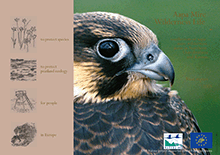Aapa Mire Wilderness Life. Southernmost aapa mire wilderness areas in Northern Ostrobothnia and Kainuu. Final report
The Natura 2000 nature conservation programme aims to preserve European natural habitats by protecting typical species and biotopes in each area of the continent. Finland has a special responsibility in the conservation of peatland biotopes, as no other European country has such extensive and varied peatlands as Finland.
The Natura 2000 areas in Litokaira, Olvassuo and Iso Tilansuo-Housusuo, located in the municipalities of Ranua, Pudasjärvi, Puolanka and Utajärvi in northern Finland, are extensive, ecologically significant mire wilderness areas. A common denominator to all of them is a mosaic-like variation of peatland and forest. Typical features of these areas include treeless aapa mires and old-growth forests. These provide ideal living conditions for many endangered animal and plant species. The area has particularly high significance for the conservation of birds. The Natura areas also have great recreational importance. These areas have always had an important role in providing local inhabitants with enjoyment. However, until now no facilities have been set up to serve local recreational purposes or nature-based tourism, a fact that has caused erosion and littering in some areas and, on the other hand, prevented the creation of sustainable nature-based tourism.
The LIFE project carried out in 2002–2005 in the Litokaira, Olvassuo and Iso Tilansuo-Housusuo Natura 2000 areas aimed to secure an adequate conservation level in the project area, sustainably harmonise various land-use forms, restore areas which have changed due to human intervention, improve awareness and proconservation attitudes in the areas and develop the possibilities for local recreation and nature-based tourism in the area. The total budget of the project was 1.7 million euros, of which the EU LIFE funding accounted for one half.
The other half was jointly financed by Metsähallitus, the North Ostrobothnia Regional Environment Centre, the town of Pudasjärvi and the municipalities of Puolanka, Ranua and Utajärvi.
The scope of the project was rather extensive and the goals were ambitious. How to combine the conservation of sensitive habitats with local recreational use and nature-based tourism? When these objectives are considered side by side, they may even appear contradictory. However, each is a part of the greater whole. These individual goals as parts of the whole can yield benefits for both the environment and the local population.
This publication presents the results and process of the project as aspects of four categories: management and land use plans, restoration, information materials and local recreational use and nature-based tourism. With the project drawing to a close, we can state that the goals have been reached and that the significance of these areas as conservation and recreational areas is broadly recognised and that their adequate conservation is safeguarded far into the future.
